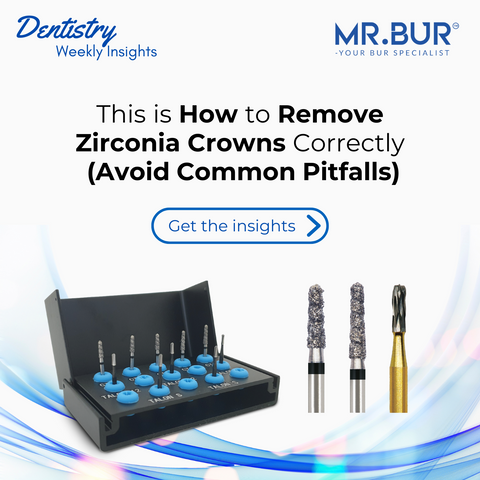Degranulation is an essential procedure in dentistry, particularly in implantology and periodontal treatment. Removing soft tissue remnants and ensuring a clean field for bone healing is critical for successful outcomes. In this guide, we will explore the best practices and tools for degranulation, helping dental professionals achieve optimal results in surgeries involving inflammation, excessive granulation, and bone correction.
A professional UK implant dentist once emphasized the importance of thoroughly cleaning the bone and maintaining a clean, degranulated field as a prerequisite for predictable outcomes in immediate placements. With this recommendation in mind, we will delve into the techniques and tools that can help ensure success.
What to Expect:
- The key role of degranulation in bone healing and dental surgery
- Essential tools for efficient and safe degranulation
- Practical steps for successful degranulation in implantology and periodontal treatments
What Is Degranulation in Dentistry?
Definition and Mechanism
Degranulation refers to the removal of inflamed soft tissue, debris, or bone fragments that can impede healing or lead to infection. In procedures like implantology and periodontal care, it ensures a clean, healthy environment that encourages proper healing and long-term success.
Why Degranulation Matters
If left untreated, residual granulation tissue can cause complications, such as delayed healing, infection, or implant failure. Proper debridement of the site ensures that infection-causing materials are removed, promoting optimal recovery.
When Is Degranulation Necessary?
Periodontal Treatment

In periodontal treatments, degranulation is essential for removing infected tissues and reducing pocket depth around teeth. Granulation tissue in these areas can contribute to periodontal disease progression. Using degranulation techniques allows for better tissue healing and improved patient outcomes in maintaining periodontal health.
Peri-implantitis Treatment

Peri-implantitis, an inflammatory condition affecting the tissues surrounding an implant, can lead to bone loss and implant failure if not managed correctly. Degranulation is crucial in this context to remove inflamed or infected tissues around the implant. This step is critical to restoring a healthy environment for bone regeneration and ensuring the longevity of the dental implant.
Granuloma and Cyst Removal

Granulomas and cysts can form around teeth or implants, often resulting from trauma, infection, or foreign materials in the oral cavity. Degranulation plays an important role in eliminating these formations, promoting proper healing, and preventing future complications.
Tools for Effective Degranulation
Importance of Selecting the Right Tools
The success of degranulation largely depends on the tools used. Dental professionals must select instruments that are precise, efficient, and safe for use around sensitive structures. The Mr. Bur Degranulation Kit is designed for this purpose, offering burs that allow for quick and easy debridement without damaging bone structure.
Mr. Bur’s Degranulation Kit: Key Features
The Mr. Bur Degranulation Kit includes a range of burs with extra coarse diamond grit, which allows for rapid degranulation while preserving the bone. With head sizes ranging from 1.0mm to 3.5mm, these burs provide flexibility for various clinical scenarios, including removing granulomas, fibrous tissues, or correcting uneven bone surfaces. Each degranulation bur features an extended neck for better visibility and safer operations near anatomical structures.
Key Burs in the Kit:
- RAXL10 (1.0mm): Fine granulation tissue removal
- RAXL25 (2.5mm): Versatile for general degranulation
- RAXL30 (3.0mm): Ideal for extensive degranulation
- RAXL35 (3.5mm): Used for correcting irregular bone surfaces
The PASS Principle: Ensuring Predictable Outcomes
In degranulation and bone surgery, following the PASS principle can ensure better healing and more predictable results:
In degranulation, following the PASS principle enhances healing:
- P: Primary wound closure ensures tension-free healing.
- A: Angiogenesis promotes healthy blood flow.
- S: Space maintenance prevents soft tissue overgrowth.
- S: Stability of the wound and implant promotes long-term success.
Incorporating the PASS principle improves results, especially in implantology and periodontal treatment.
Step-by-Step Degranulation Process
1. Initial Examination and Debridement
Before starting the procedure, lift the mucoperiosteal flap to expose the surgical site. Examine the condition of the alveolar ridge and surrounding tissues for signs of inflammation, granulomas, or fibrous tissue. Use a surgical curette to carefully explore the extent of tissue involvement and scrape away any obvious soft tissue debris.
2. Removal of Soft Tissue and Granulation
For more detailed degranulation, select an appropriately sized bur from the Mr. Bur Degranulation Kit and use saline irrigation to cool the area. Operate at a speed of 300-500 RPM to safely remove fibrous tissue and granulation. This step clears the way for successful bone regeneration or implant placement.
3. Refining the Bone Surface
Once the soft tissue has been removed, refine the osseous structure using the larger burs (RAXL30 or RAXL35) at 800-1200 RPM. This helps to correct any irregularities in the bone surface, ensuring better stability for implants or grafting materials. The precision of the extra coarse diamond burs ensures minimal trauma to the bone.
4. Ensuring Proper Closure
After completing the degranulation process, primary closure is essential to prevent wound dehiscence. Ensure that the surgical site is tension-free, and if needed, use a barrier membrane to maintain space for bone grafts and prevent soft tissue infiltration. Maintaining stability through proper closure will aid in angiogenesis and promote faster healing.
Post-Degranulation Considerations
Primary Closure and Stability
After degranulation, it is critical to achieve primary closure of the surgical site. A tension-free closure promotes better healing by reducing the risk of reopening or infection. Additionally, ensuring stability of the wound and implant helps in maintaining space and allowing for proper bone regeneration.
Monitoring and Follow-Up
Post-surgical care is essential for monitoring the healing process. Regular follow-ups ensure that any potential complications are caught early, and they allow for assessment of the success of the degranulation process. Patients should also be educated on proper post-operative care, such as avoiding trauma to the surgical site and maintaining good oral hygiene.
Conclusion: Achieving Success with Proper Degranulation
Degranulation is a key element in many dental procedures, from periodontal treatment to implantology. Using the right tools and following the proper technique ensures that the procedure is effective, safe, and successful.
Are you utilizing the most efficient degranulation techniques in your practice? Subscribe for updates or invest in the Mr. Bur Degranulation Kit today to elevate your patient outcomes.
Diamond Burs, Carbide Burs, Surgical & Lab Use Burs, Endodontic burs, IPR Kit, Crown Cutting Kit, Gingivectomy Kit, Root Planning Kit, Orthodontic Kit, Composite Polishers, High Speed Burs, Low Speed Burs





